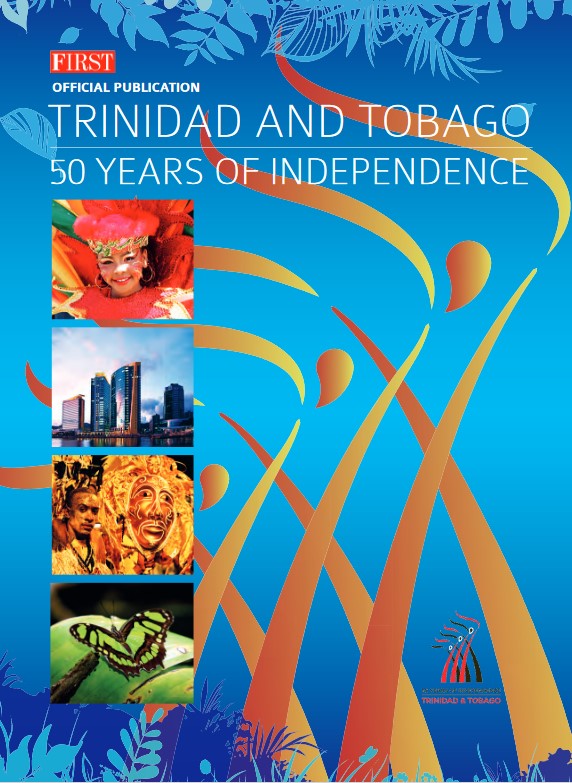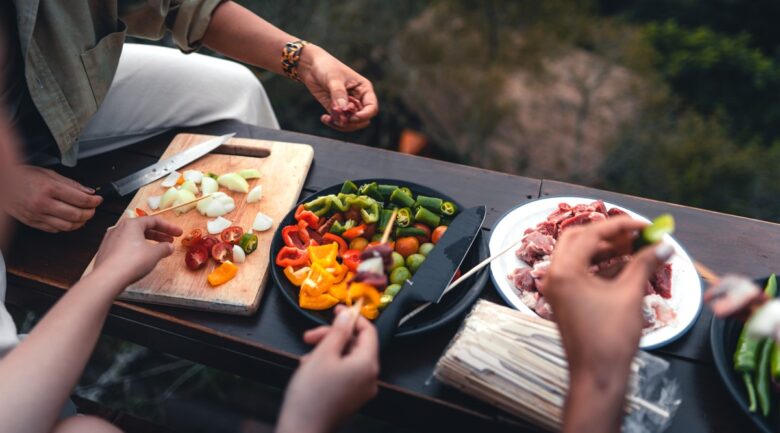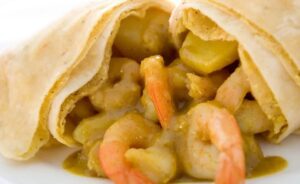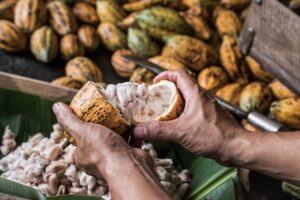Contents
A. Brief Overview of Indo-Trinidadian Cuisine
When you think of the Caribbean, images of pristine beaches and crystal-clear waters may come to mind. But there’s another aspect of the Caribbean that often goes unnoticed, and it’s just as captivating – the rich tapestry of flavors that make up the Indo-Trinidadian cuisine. Nestled in the heart of Trinidad and Tobago, this unique culinary tradition is a testament to the island’s history, cultural diversity, and culinary expertise.
B. Importance of Exploring the Fusion of Indian and Trinidadian Flavors
In the bustling kitchens and lively markets of Trinidad, something extraordinary happens when Indian spices and techniques meet the vibrant ingredients of the Caribbean. It’s a fusion that has been evolving for generations, resulting in a cuisine that is a testament to the island’s history of immigration, adaptation, and innovation.
The Indo-Trinidadian culinary adventure is more than just a delightful journey for your taste buds; it’s a celebration of cultural exchange and a living testament to the blending of traditions that make Trinidad and Tobago a true melting pot of flavors.
C. Thesis Statement: “This article explores the rich Indo-Trinidadian culinary journey, from traditional recipes to modern twists.”
In this article, we’ll take you on a culinary voyage through the Indo-Trinidadian heritage, where every dish tells a story and every bite is a fusion of history and flavor. From the roots of this cuisine to the modern interpretations that grace the tables of Trinidadian households and restaurants, we will delve into the world of Indo-Trinidadian cooking. Along the way, we’ll uncover the secrets behind traditional dishes, explore the influence of curry, and savor the sweet side of this remarkable culinary adventure. Join us as we embark on a gastronomic journey that transcends borders and invites you to savor the extraordinary fusion of Indian and Trinidadian flavors in every bite.
II. Historical Roots
A. Tracing the Migration of Indian Indentured Laborers to Trinidad
To truly appreciate the depth and complexity of Indo-Trinidadian cuisine, we must first journey back in time to the mid-19th century. It was during this period that thousands of Indian indentured laborers made the arduous voyage from the Indian subcontinent to the shores of Trinidad. These laborers were brought to the Caribbean under indenture contracts, a system that replaced slavery and aimed to supply cheap labor to the British colonies.
Their arrival marked the beginning of a profound cultural exchange, as they carried with them not only their labor but also their culinary traditions, which would forever transform the culinary landscape of Trinidad. The aromatic spices, cooking techniques, and recipes they brought with them laid the foundation for what would become Indo-Trinidadian cuisine.
B. Influence of Indian Culture on Trinidadian Society and Cuisine
The influence of Indian culture in Trinidad extends far beyond the realm of food. The arrival of indentured laborers significantly contributed to the cultural mosaic of the island, shaping its language, religion, music, and dance. Hinduism, Islam, and Sikhism found a new home in Trinidad, coexisting with Christianity and other faiths, creating a tapestry of beliefs that is still evident today.
In the kitchen, the fusion of Indian flavors with Caribbean ingredients led to the birth of a culinary tradition like no other. The use of spices such as turmeric, cumin, and cardamom, as well as cooking methods like tandoor grilling and slow simmering, merged seamlessly with locally available ingredients like coconut, cassava, and plantains. This blending of cultures and ingredients gave rise to dishes that are both delicious and deeply rooted in Trinidadian identity.
C. The Evolution of Indo-Trinidadian Cuisine Over the Years
As generations passed and Indo-Trinidadian families continued to adapt to their new surroundings, their cuisine evolved. What started as a preservation of ancestral traditions gradually transformed into a dynamic fusion of flavors, reflecting the changing tastes and ingredients available in Trinidad and Tobago.
Over the years, Indo-Trinidadian cuisine has evolved to incorporate influences from other cultures present on the islands, including African, Chinese, and Creole. This fusion has led to the development of unique dishes and culinary techniques that are a testament to Trinidad’s multicultural heritage.
In the next sections of this article, we will explore some of the traditional Indo-Trinidadian dishes that have stood the test of time and the role of curry in shaping this culinary adventure. Join us on this flavorful journey through history and taste.
III. Traditional Indo-Trinidadian Dishes
A. Description of Key Ingredients and Cooking Techniques
Before we delve into the mouthwatering world of traditional Indo-Trinidadian dishes, it’s essential to understand the foundational elements that give these creations their distinctive flavors and textures. The artistry of Indo-Trinidadian cuisine is deeply rooted in the use of key ingredients and cooking techniques.
In the kitchen, aromatic spices such as curry powder, cumin, coriander, and turmeric reign supreme. These spices are meticulously combined to create complex, layered flavors that are both savory and aromatic. Cooking techniques like slow simmering and marinating are used to coax the maximum flavor from these ingredients.
Moreover, the use of coconut milk and various forms of dal (split peas) is prevalent, adding a creamy and hearty texture to many dishes. The careful balance of these elements is what makes Indo-Trinidadian cuisine a gastronomic masterpiece.
B. Popular Dishes like Roti, Doubles, and Aloo Pie
Now, let’s turn our attention to some of the iconic dishes that define Indo-Trinidadian cuisine:
- Roti: Roti, a type of flatbread, is the cornerstone of Trinidadian cuisine. It’s made from unleavened dough and can be filled with a variety of savory ingredients like curried vegetables, chicken, or goat. The skill lies in creating the perfect balance between the soft, flaky layers of the bread and the flavorful fillings.
- Doubles: Doubles are a beloved street food in Trinidad. They consist of two soft, fried bread-like patties, known as bara, filled with a generous serving of curried chickpeas. Topped with a variety of chutneys and hot pepper sauce, doubles are a delightful explosion of flavors and textures.
- Aloo Pie: Aloo Pie is another popular snack, featuring a spiced potato filling enclosed in a crispy pastry shell. It’s often enjoyed with tamarind or mango chutney for a sweet and tangy contrast.
C. Insights into the Significance of These Dishes in Trinidadian Culture
Beyond their delectable tastes, these traditional dishes hold a profound cultural significance in Trinidadian society. They serve as a bridge between the past and the present, connecting generations and preserving the memory of the Indian indentured laborers who shaped the country’s culinary landscape.
Dishes like Roti, Doubles, and Aloo Pie are not just meals; they are expressions of cultural identity and community. They are often prepared and enjoyed in family gatherings, religious ceremonies, and street food festivals, fostering a sense of togetherness and belonging.
As we continue our journey through Indo-Trinidadian cuisine, we will uncover more culinary gems and explore the role of curry in elevating these dishes to new heights. Join us as we savor the flavors and stories of Trinidad’s vibrant culinary heritage.
IV. The Role of Curry
A. Exploring the Importance of Curry in Indo-Trinidadian Cuisine
Curry is the heart and soul of Indo-Trinidadian cuisine, and its significance in shaping the flavors of this culinary adventure cannot be overstated. It’s the aromatic blend of spices that infuses each dish with a burst of warmth and complexity, making every bite an unforgettable experience.
Curry, in the Trinidadian context, is not merely a spice; it’s a cultural bridge that connects the Indian heritage of indentured laborers with the Caribbean ingredients that became available to them. It represents the fusion of two worlds, where Indian curry recipes met the vibrant tropical produce of Trinidad and Tobago. This fusion gave rise to a diverse range of curry dishes that are now integral to Trinidadian cuisine.
B. Different Types of Curry (Chicken, Goat, Shrimp, etc.) and Their Unique Flavors
In Indo-Trinidadian cuisine, curry comes in a variety of forms, each offering a unique and tantalizing taste experience:
- Chicken Curry: Chicken curry is a beloved classic, featuring tender pieces of chicken simmered in a rich, aromatic gravy made with a medley of spices, tomatoes, and onions. The result is a harmonious blend of flavors with a hint of heat and a touch of sweetness.
- Goat Curry: Goat meat, prized for its robust and slightly gamey flavor, is a favorite protein for curry in Trinidad. The slow-cooked goat curry is a mouthwatering delight, with tender meat that absorbs the spices beautifully.
- Shrimp Curry: Seafood lovers can indulge in the succulent pleasures of shrimp curry. The delicate sweetness of shrimp pairs exquisitely with the bold flavors of the curry sauce, creating a dish that’s both elegant and satisfying.
- Vegetable Curry: For those seeking a vegetarian option, vegetable curry is a colorful and flavorful choice. It combines an assortment of seasonal vegetables with the aromatic curry sauce, resulting in a nutritious and satisfying meal.
C. Tips for Making an Authentic Indo-Trinidadian Curry at Home
Creating an authentic Indo-Trinidadian curry at home is an art that requires a good understanding of the essential techniques and spices. Here are some tips to help you embark on your culinary journey:
- Use Fresh Spices: Freshly ground spices are key to achieving the vibrant flavors of Trinidadian curry. Invest in whole spices and grind them as needed for the best results.
- Layer Your Spices: Building layers of flavor is crucial in curry-making. Start by tempering whole spices in hot oil to release their essence, then add ground spices and aromatics like garlic, ginger, and onions.
- Balance the Heat: Adjust the heat level to your preference by adding or reducing hot peppers (such as Scotch bonnet or habanero) and seeds. Remember, the heat should complement the other flavors, not overpower them.
- Slow Simmering: Allow your curry to simmer slowly, letting the meat or vegetables absorb the flavors over time. This slow cooking process is essential for tender and flavorful results.
- Fresh Herbs: Finish your curry with fresh herbs like cilantro or curry leaves to add a burst of freshness and fragrance.
By following these tips, you can master the art of making an authentic Indo-Trinidadian curry that pays homage to the rich tradition and exquisite flavors of this beloved cuisine. In the next section, we’ll venture into the world of fusion cuisine and modern twists that continue to evolve the Indo-Trinidadian culinary adventure.
V. Fusion Cuisine and Modern Twists
A. Creative Adaptations of Indo-Trinidadian Dishes
While traditional Indo-Trinidadian dishes remain the heart of the cuisine, creative adaptations and modern twists have breathed new life into this culinary tradition. Chefs and home cooks alike have embraced innovation while preserving the essence of the original flavors.
One exciting development is the incorporation of international ingredients and techniques into traditional dishes. This fusion not only adds excitement to the dining experience but also reflects the multicultural influences shaping Trinidadian cuisine today. For example, you might encounter dishes like coconut shrimp roti or jerk chicken with a curry twist.
B. The Influence of Other Cultures on Trinidadian Cuisine
Trinidad and Tobago’s multicultural society has always welcomed a diverse range of culinary influences. Beyond the Indian and Caribbean fusion, the cuisine is a tapestry woven with threads from around the world. African, Chinese, Middle Eastern, and European culinary elements have all found their place in Trinidadian kitchens.
Chinese-style noodles, known locally as chow mein, are a popular street food, while Middle Eastern shawarma stands are a common sight. These global flavors have seamlessly integrated into the local food scene, resulting in a vibrant and diverse culinary landscape.
C. Must-Try Fusion Dishes and Where to Find Them
If you’re eager to explore the world of fusion cuisine in Trinidad and Tobago, here are some must-try dishes and places to find them:
- Doubles with a Twist: Seek out street vendors offering innovative doubles variations, such as doubles with grilled shrimp or BBQ pulled pork. The lively streets of Port of Spain are excellent places to start.
- Roti Fusion: Visit restaurants that specialize in roti and discover inventive fillings like curry chicken and Thai basil or tandoori paneer with Mediterranean-style hummus. Look for eateries in Trinidad’s urban centers for these creative delights.
- Caribbean Sushi: Some sushi restaurants in Trinidad fuse Caribbean ingredients like mango and plantains with traditional Japanese sushi techniques. It’s a delightful fusion of flavors and cultures that’s worth experiencing.
- International-Inspired Curry: Explore upscale restaurants in Trinidad’s capital, where chefs experiment with curry dishes that draw inspiration from cuisines as diverse as French, Thai, and Italian.
Incorporating global influences into Indo-Trinidadian cuisine has given birth to a culinary landscape that’s both dynamic and exciting. These fusion dishes provide a unique window into the ever-evolving nature of Trinidadian cuisine, where creativity knows no bounds. As we continue our culinary adventure, we’ll turn our attention to the bustling street food culture and the delectable treats it has to offer.
VI. The Street Food Culture
A. The Vibrant Street Food Scene in Trinidad
Trinidad’s street food scene is a vibrant and kaleidoscopic world of flavors, aromas, and cultural diversity. It’s a place where culinary traditions come alive, where the sizzle of grills and the wafting scents of spices create an intoxicating atmosphere that beckons locals and visitors alike.
From bustling urban centers to serene coastal towns, street food vendors can be found at every corner, offering a tantalizing array of dishes that span the spectrum of Trinidadian cuisine. Whether you’re craving savory classics like doubles and roti or looking for sweet treats to satisfy your palate, the streets of Trinidad have you covered.
B. Street Food Vendors and Their Contributions to the Culinary Landscape
The unsung heroes of Trinidad’s culinary landscape are the street food vendors who tirelessly craft these delectable dishes day in and day out. They are the embodiment of passion, expertise, and tradition, preserving the authenticity of their recipes while infusing them with their unique personal touches.
Many of these vendors have passed down their trade through generations, ensuring that the art of making traditional dishes like doubles and shark and bake remains alive and thriving. These street food artisans not only serve delicious food but also contribute to the cultural fabric of Trinidad, preserving the heritage of Indo-Trinidadian cuisine for future generations.
C. Street Food Etiquette and Recommendations for Trying Street Food
When indulging in Trinidad’s street food culture, there are some etiquette tips and recommendations to keep in mind for a memorable and enjoyable experience:
- Hygiene Matters: Look for vendors who maintain clean and hygienic cooking practices. A crowded stall with a long line is often a good sign of quality and cleanliness.
- Embrace the Adventure: Be open to trying new dishes and flavors you may not have encountered before. Street food is an opportunity to expand your palate and savor the diversity of Trinidad’s cuisine.
- Engage with Locals: Strike up a conversation with locals while waiting in line or enjoying your meal. They can offer valuable insights into the best vendors and hidden gems in the area.
- Try a Variety: Share dishes with friends and family to sample a wide range of flavors. Street food is all about sharing and enjoying communal meals.
- Condiment Choices: Experiment with different condiments and sauces offered by the vendors. From fiery hot pepper sauces to tangy chutneys, these add-ons can elevate your street food experience.
- Cash is King: Street food vendors often prefer cash payments, so make sure to carry some Trinidadian dollars with you.
- Timing Matters: Street food vendors typically operate during specific hours, so plan your visit accordingly. Some dishes, like bake and shark, are often best enjoyed during lunchtime.
Exploring Trinidad’s street food culture is an adventure for the senses, offering an authentic taste of the island’s culinary soul. It’s an experience that connects you not only to the food but also to the warm and welcoming spirit of the Trinidadian people. In our next section, we’ll explore the sweet side of Indo-Trinidadian cuisine, where desserts and sweets take center stage.
VII. The Sweet Side of Indo-Trinidadian Cuisine
A. Desserts and Sweets with Indian Influences
The sweet side of Indo-Trinidadian cuisine is a delightful journey into a world of flavors that bear the unmistakable influence of India. These desserts and sweets are not only a testament to the enduring connection to Indian traditions but also a showcase of the creativity and ingenuity of Trinidadian bakers and home cooks.
Indian-inspired sweets in Trinidad often feature ingredients such as ghee, cardamom, saffron, and condensed milk. These ingredients are skillfully combined to create confections that are both rich and fragrant, making them perfect for special occasions, celebrations, and, of course, satisfying your sweet tooth.
B. Iconic Sweets like Barfi, Gulab Jamun, and Saheena
- Barfi: Barfi is a classic Indian sweet that has found a beloved home in Trinidad. Made from condensed milk and flavored with cardamom, it’s often garnished with chopped nuts. The result is a fudgy, sweet treat that melts in your mouth.
- Gulab Jamun: Gulab Jamun is another Indian favorite that has been adopted and cherished in Trinidad. These soft, golden-brown dumplings are soaked in a fragrant rosewater and saffron syrup, creating a delectable combination of sweet and floral flavors.
- Saheena: Saheena is a popular Trinidadian street food snack that blends Indian and Caribbean influences. It consists of deep-fried dough made from ground split peas and flour, seasoned with various spices. Saheena is often served with tamarind chutney for a tangy contrast.
C. Where to Satisfy Your Sweet Tooth in Trinidad
When it comes to satisfying your sweet tooth in Trinidad, you’ll find a wealth of options, from traditional sweet shops to local bakeries and street food vendors. Here are a few recommendations for indulging in Indo-Trinidadian sweets:
- Sweet Shops: Look for dedicated sweet shops, often run by families with a passion for preserving their culinary heritage. These establishments offer a wide range of traditional sweets like barfi, gulab jamun, and more.
- Local Bakeries: Many local bakeries in Trinidad offer a selection of Indian-inspired sweets alongside their regular pastry offerings. It’s a great place to sample a variety of treats.
- Street Food Markets: Explore the street food markets in Port of Spain and other urban centers, where you’ll find vendors selling saheena and other delectable sweets.
- Special Occasions: If you have the opportunity to attend a Trinidadian celebration or festival, keep an eye out for sweet stalls offering an array of delightful treats.
Indulging in Indo-Trinidadian sweets is a delightful way to cap off your culinary adventure. These desserts are not just a feast for the taste buds; they also provide a sweet connection to the rich history and traditions of Trinidad and Tobago. As we conclude our exploration of Indo-Trinidadian cuisine, we’ll reflect on the significance of food in understanding Trinidad’s history and people.
VIII. Exploring Trinidad Through Its Food
A. The Connection Between Food and Cultural Identity
Food is more than just sustenance; it’s a profound expression of cultural identity. In Trinidad and Tobago, where multiculturalism is celebrated, this connection between food and identity is especially pronounced. Each dish, each spice, and each cooking technique carries with it a piece of history, a memory of migration, and a celebration of diversity.
Trinidad’s culinary tapestry reflects the mosaic of its population, from the Indian influences of roti and curry to the African roots of callaloo and pelau, and the global influences that have shaped its street food culture. Food is a language that transcends words, telling stories of resilience, adaptation, and the shared experiences of a nation.
B. Recommended Restaurants and Food Markets for an Authentic Culinary Experience
To truly savor the flavors of Trinidad and Tobago and immerse yourself in its culinary culture, here are some recommended spots:
- Maracas Bay Bake and Shark Stalls: Located along the picturesque Maracas Beach, these stalls serve mouthwatering bake and shark sandwiches, a beloved Trinidadian specialty. Customize your toppings and savor the ocean view.
- Queen’s Park Savannah Food Vendors: In the heart of Port of Spain, the Queen’s Park Savannah comes alive with food vendors in the evenings. Sample local favorites like corn soup, doubles, and more.
- Lal’s Curry House: For a taste of authentic Indo-Trinidadian cuisine, Lal’s Curry House in Chaguanas is a must-visit. Their curries and rotis are known for their bold flavors and quality ingredients.
- Chaud Restaurant: Located in Port of Spain, Chaud Restaurant offers a fine dining experience with a fusion of international and Caribbean flavors. It’s an excellent choice for a special culinary evening.
- St. James Food Market: This food market in St. James, a suburb of Port of Spain, is a treasure trove of Trinidadian street food. Try local favorites like pelau and corn soup.
C. The Significance of Food in Understanding Trinidad’s History and People
To truly understand Trinidad and Tobago, one must delve into its culinary history. Food has played a pivotal role in shaping the nation’s story, from the arrival of indentured laborers and enslaved Africans to the influence of Chinese, Syrian, and European settlers. It’s a history that unfolds on your plate, offering a glimpse into the resilience and creativity of a diverse and harmonious society.
Through its food, Trinidad tells a story of unity in diversity, where different cultures coexist and enrich one another. It’s a place where you can savor the essence of multiculturalism and appreciate the warmth and hospitality of its people.
As you explore Trinidad and Tobago through its food, you embark on a sensory journey that not only delights your palate but also deepens your understanding of the nation’s history, culture, and soul. So, savor every bite, embrace the diversity, and let the flavors of Trinidad and Tobago transport you to a world where food is a celebration of life itself.
IX. Conclusion
A. Recap of the Indo-Trinidadian Culinary Journey
In our culinary expedition through Trinidad and Tobago, we’ve traversed a landscape rich in history, flavor, and cultural diversity. From the arrival of Indian indentured laborers to the vibrant street food stalls and the sweet delights that grace the tables, the Indo-Trinidadian culinary journey is a tapestry woven with threads of tradition, innovation, and multiculturalism.
We’ve explored the foundational role of curry, the significance of iconic dishes like roti and doubles, and the fusion of flavors that characterize this cuisine. We’ve ventured into the bustling street food culture, indulged in sweet treats with Indian influences, and discovered the profound connection between food and cultural identity.
B. Encouragement for Readers to Explore and Enjoy this Unique Fusion of Flavors
As we conclude our exploration, we extend an invitation to all food enthusiasts and travelers to embark on their own culinary adventure through Trinidad and Tobago. Dive into the world of Indo-Trinidadian cuisine, where each bite tells a story and every dish is a celebration of cultural exchange.
Visit the street food stalls, savor the rich curries, and experience the warmth of Trinidad’s food culture. Whether you’re a seasoned foodie or a curious traveler, there’s something uniquely captivating about the flavors of this island nation.
C. Final Thoughts on the Richness of Trinidad’s Food Culture
In closing, Trinidad’s food culture is not just about what’s on the plate; it’s about the people who craft these culinary wonders and the history that has shaped them. It’s a testament to the ability of diverse cultures to come together and create something beautiful, flavorful, and harmonious.
In the vibrant, colorful, and aromatic world of Trinidadian cuisine, you’ll find not only delicious meals but also the heart and soul of a nation. So, savor every dish, embrace the diversity, and let the richness of Trinidad’s food culture be a source of inspiration and celebration. As you explore the fusion of Indian and Trinidadian flavors, you’ll discover a world where food is a bridge that brings people together, transcending borders and uniting hearts.
- How to Download the E-book

The “Trinidad and Tobago 50
th Anniversary Book” can be downloaded by visiting [provide website or link]. This digital resource offers an immersive experience into the history and culture of Trinidad and Tobago, enriched with photographs, narratives, and insights.




